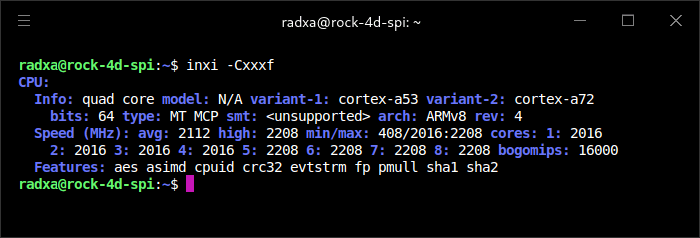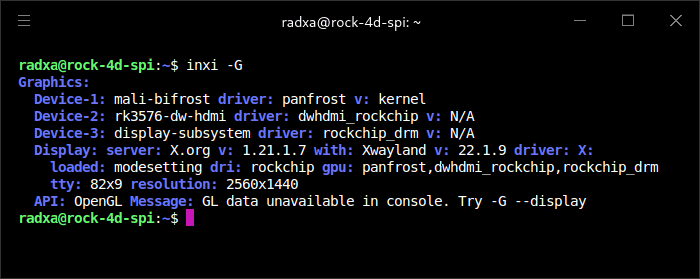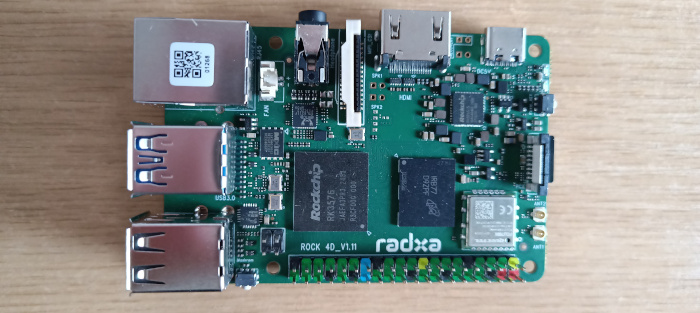Interrogation of the system
Let’s first see the kernel I’m running.

Now I’ll install inxi, a command line system information tool that provides a wealth of information.
$ sudo apt install inxi

Processor

The ROCK 4D has a quad core Cortex-A72 and a quad core Cortex A-53.
Not shown, there’s also a Neural Processing Unit. It is 6 TOPS (supports INT4 / INT8 / INT16 / FP16 / BF16 / TF32).
Graphics

The board has the Arm Mali-G52 MC3 GPU. I’ve got the machine connected to a 1440p monitor over HDMI. There’s also the option of connecting via MIPI DSI: 1× 4-lane MIPI DSI.
Disk

I’m using a 256GB microSD card.
The ROCK 4D also features an onboard eMMC/UFS combo module interface. I can plugin a UFS module which can be used as a system boot drive or for expanding storage capacity.
There’s a 16MB SPI NOR Flash (which is the equivalent to a BIOS).
Memory

The ROCK 4D is available with either 2GB, 4GB, 8GB, or 16GB of DDR5 RAM. My computer has 2GB. If you’re thinking of running a desktop environment on the machine, I strongly recommend getting more than 2GB of RAM. Even with a few apps open, I’m into swap territory. But if you’re not going to use KDE Plasma much, the 2GB model has the benefit of being much cheaper.
Network

There’s a single Gigabit ethernet port as well as Wi-Fi 6.
Bluetooth

Bluetoogh 5.4 is available and works without any tinkering needed.
Temperature

I’m using the industrial model of the ROCK 4D which can run from -40°C to 85°C.
With a room temperature of 24.2°C, the machine has a system temperature of 49.9°C. That’s with the machine under no load, but with no heatsink or fan.
Other hardware:
The machine has a MIPI CSI 1 x 4 lane (configurable as 2x 2-lane) + 1x 2-lane CSI. There’s a 3.5mm audio jack, 2 USB 3.0 and 2 USB 2.0 ports. For expansion, there’s a GPIO header supporting UART, SPI, I2C, I2S, PWM, CAN, ADC, etc., as well as a PCIe Slot: PCIe 2.1 x1 via FPC interface .
For the next article in this series, I’ll be running a series of benchmarks on the ROCK 4D and comparing its results to other SBCs and mini PCs.
Pages in this article:
Page 1 – Introduction
Page 2 – Radxa OS
Page 3 – Interrogation of the system
Complete list of articles in this series:
| Radxa ROCK 4D | |
|---|---|
| Introduction | Introduction to the series and interrogation of the ROCK 4D |
| Benchmarks | Benchmarking the ROCK 4D |
| Power | I compare the ROCK 4D's power consumption to other machines |
| Radxa OS | A Debian-based Linux distribution with KDE Plasma |

How much does the 2GB version cost?
On AliExpress the 2GB model costs £28.89.
Other models:
4GB £39.29
8GB £57.79
16GB £96.99